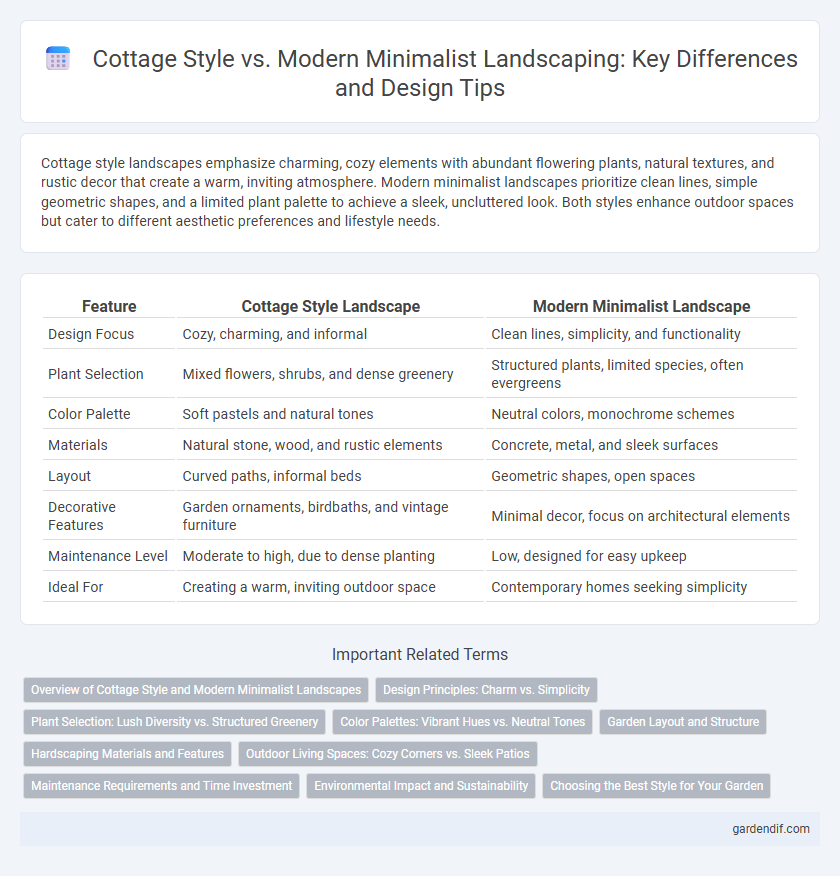
Cottage Style vs Modern Minimalist Illustration
Cottage style landscapes emphasize charming, cozy elements with abundant flowering plants, natural textures, and rustic decor that create a warm, inviting atmosphere. Modern minimalist landscapes prioritize clean lines, simple geometric shapes, and a limited plant palette to achieve a sleek, uncluttered look. Both styles enhance outdoor spaces but cater to different aesthetic preferences and lifestyle needs.
Table of Comparison
| Feature | Cottage Style Landscape | Modern Minimalist Landscape |
|---|---|---|
| Design Focus | Cozy, charming, and informal | Clean lines, simplicity, and functionality |
| Plant Selection | Mixed flowers, shrubs, and dense greenery | Structured plants, limited species, often evergreens |
| Color Palette | Soft pastels and natural tones | Neutral colors, monochrome schemes |
| Materials | Natural stone, wood, and rustic elements | Concrete, metal, and sleek surfaces |
| Layout | Curved paths, informal beds | Geometric shapes, open spaces |
| Decorative Features | Garden ornaments, birdbaths, and vintage furniture | Minimal decor, focus on architectural elements |
| Maintenance Level | Moderate to high, due to dense planting | Low, designed for easy upkeep |
| Ideal For | Creating a warm, inviting outdoor space | Contemporary homes seeking simplicity |
Overview of Cottage Style and Modern Minimalist Landscapes
Cottage style landscapes emphasize lush, informal gardens filled with a variety of flowering plants, winding paths, and cozy, rustic elements that create a warm, inviting atmosphere. Modern minimalist landscapes focus on simplicity and functionality, using clean lines, limited plant varieties, and open spaces with materials like concrete, metal, and gravel to achieve a sleek, uncluttered look. Both styles offer distinct aesthetic approaches: cottage style promotes natural charm and abundance, while modern minimalist delivers streamlined, contemporary elegance.
Design Principles: Charm vs. Simplicity
Cottage style landscapes emphasize charm through layered plantings, vintage garden accessories, and cozy, uneven pathways that create an inviting, nostalgic atmosphere. Modern minimalist landscapes focus on simplicity by using clean lines, open spaces, and a restrained color palette to achieve a sleek, functional aesthetic. The cottage style thrives on abundant textures and organic forms, while modern minimalist design prioritizes order, symmetry, and minimal visual clutter.
Plant Selection: Lush Diversity vs. Structured Greenery
Cottage style landscapes emphasize a lush diversity of plants, blending colorful perennials, wildflowers, and dense foliage to create a vibrant, natural look. In contrast, modern minimalist gardens prioritize structured greenery, using carefully selected shrubs, ornamental grasses, and sculptural plants like boxwoods and succulents for clean lines and simplicity. Plant selection in cottage gardens fosters biodiversity and seasonal interest, while modern minimalist design focuses on uniformity and low-maintenance aesthetics.
Color Palettes: Vibrant Hues vs. Neutral Tones
Cottage style landscapes embrace vibrant hues such as soft pastels, rosy pinks, and sunny yellows to create a warm, inviting atmosphere that highlights floral diversity and whimsical garden elements. Modern minimalist gardens prioritize neutral tones like grays, whites, and muted greens, emphasizing clean lines and simplicity to enhance spatial harmony and a tranquil ambiance. The choice between vibrant cottage palettes and understated minimalist neutrals significantly influences the emotional impact and visual rhythm of outdoor spaces.
Garden Layout and Structure
Cottage style gardens feature irregular, organic layouts with winding paths, mixed flower beds, and rustic wooden structures that create a cozy, natural atmosphere. In contrast, modern minimalist gardens emphasize clean lines, geometric shapes, and open spaces with sleek materials like concrete, metal, and gravel to promote simplicity and order. Both styles use distinct planting arrangements and structural elements to convey either warmth and charm or sophistication and restraint.
Hardscaping Materials and Features
Cottage Style landscapes emphasize natural hardscaping materials such as flagstone, cobblestone, and rustic brick, creating a warm, inviting atmosphere with features like arbors, garden benches, and curved pathways. Modern Minimalist landscapes prioritize sleek, uniform materials like concrete, steel, and large-format pavers, with clean lines and features including geometric fire pits, linear water elements, and minimalist retaining walls. The contrast between the two styles lies in Cottage's organic, textured surfaces versus Modern Minimalist's smooth, polished finishes and structured layouts.
Outdoor Living Spaces: Cozy Corners vs. Sleek Patios
Cottage style outdoor living spaces emphasize cozy corners with lush greenery, vintage furniture, and textured fabrics that create a warm, inviting atmosphere. Modern minimalist patios feature clean lines, neutral color palettes, and functional design elements such as built-in seating and minimalist planters that promote simplicity and elegance. Both styles optimize outdoor living by balancing comfort and aesthetics tailored to different lifestyle preferences.
Maintenance Requirements and Time Investment
Cottage style gardens demand frequent upkeep due to diverse plant varieties, requiring regular pruning, watering, and seasonal care to maintain their lush, whimsical appearance. Modern minimalist landscapes feature streamlined designs with hardy, low-maintenance plants and materials like gravel, concrete, and synthetic turf that significantly reduce maintenance time. Homeowners seeking low time investment benefit from minimalist gardens, while cottage gardens suit those who enjoy hands-on, ongoing garden care.
Environmental Impact and Sustainability
Cottage Style landscaping emphasizes diverse native plants, promoting local biodiversity and natural habitats that enhance ecosystem resilience. Modern Minimalist designs reduce water use and chemical inputs through simplified plant palettes and efficient irrigation systems, supporting sustainable resource management. Both styles contribute to environmental impact mitigation by encouraging sustainable practices tailored to their unique aesthetic principles.
Choosing the Best Style for Your Garden
Cottage style gardens feature lush, densely planted flower beds with a mix of colorful perennials and climbing vines, creating a charming, naturalistic atmosphere. Modern minimalist gardens prioritize clean lines, open spaces, and a limited palette of plants, often using succulents, ornamental grasses, and simple hardscaping materials like concrete or gravel. Choosing the best style depends on personal preference, garden size, and maintenance willingness, with cottage style suited for those desiring a cozy, vibrant space and modern minimalist ideal for sleek, low-maintenance outdoor environments.
Cottage Style vs Modern Minimalist Infographic

 gardendif.com
gardendif.com